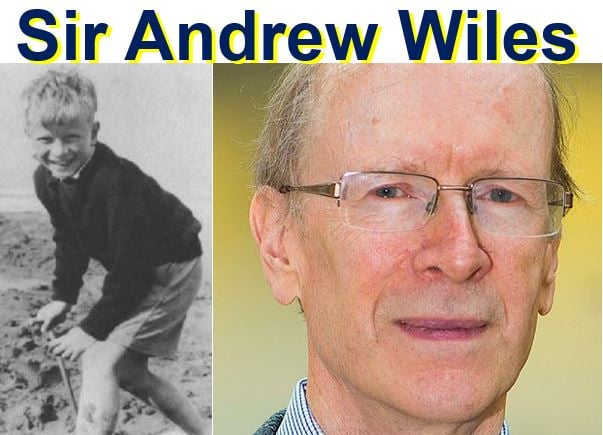A centuries old mathematical mystery – Fermat’s Last Theorem – was solved by Sir Andrew Wiles, an Oxford University Professor, in 1993. This week, he learned that he has been awarded the £0.5 million 2016 Abel Prize.
The Abel Prize is the equivalent of the Nobel Prize in the world of mathematics. Named after Norwegian mathematician Niels Henrik Abel (1802–1829), it is awarded each year by the Government of Norway – specifically, The Norwegian Academy of Science and Letters – to one or more outstanding mathematicians.
For over three hundred years, mathematicians across the world had been trying unsuccessfully to find proof of Fermat’s Last Theorem, that is, until 1993.
 Portrait of Pierre de Fermat with the equation of his Theorem below. Fermat’s Last Theorem took 358 years to solve.
Portrait of Pierre de Fermat with the equation of his Theorem below. Fermat’s Last Theorem took 358 years to solve.
‘Stunning proof’ of Fermat’s Last Theorem
The Norwegian Academy of Science and Letters said it has awarded the Abel Prize to Sir Andrew:
“For his stunning proof of Fermat’s Last Theorem by way of the modularity conjecture for semistable elliptic curves, opening a new era in number theory.”
In May this year, Sir Andrew, Royal Society Research Professor of Mathematics at Oxford, will travel to Oslo where he will receive the Prize from Crown Prince Haakon of Norway at a ceremony.
When he learned that he had won the prize, Sir Andrew said:
“It is a tremendous honour to receive the Abel Prize and to join the previous Laureates who have made such outstanding contributions to the field. Fermat’s equation was my passion from an early age, and solving it gave me an overwhelming sense of fulfilment.”
 Winning the Abel Prize is equivalent to being awarded the Nobel Prize in mathematics. (Image: abelprize.no)
Winning the Abel Prize is equivalent to being awarded the Nobel Prize in mathematics. (Image: abelprize.no)
“It has always been my hope that my solution of this age-old problem would inspire many young people to take up mathematics and to work on the many challenges of this beautiful and fascinating subject.”
Theorem seemingly intractable
Fermat’s Last Theorem, first formulated by Pierre de Fermat (1601-1665), had been regarded by most mathematicians as seemingly intractable.
The Theorem states:
There are no whole number solutions to the equation
Xn + Yn = Zn
when n is greater than 2
Fermat, a French lawyer at the Toulouse Parliament, and a mathematician credited for early developments that led to infinitesimal calculus, claimed he found a proof for the theorem, but explained that the margin of the text he had been making notes on was not wide enough to contain it.
As a boy, Sir Andrew became fascinated with the problem. Following seven years of intense study in private at Princeton University, New Jersey, USA, he announced that he had found a proof in 1993, combining three complex mathematical fields – elliptic curves, modular forms, and Galois representations.
Discovery created new directions in mathematics
He not only solved the centuries-old puzzle of the Theorem, but in doing so also created entirely new directions in mathematics, which have become invaluable to other scientists and mathematicians in the years since 1993.
 Sir Andrew Wiles, born in Cambridge in 1953, became fascinated by Fermat’s Last Theorem when he was a schoolboy.
Sir Andrew Wiles, born in Cambridge in 1953, became fascinated by Fermat’s Last Theorem when he was a schoolboy.
The Norwegian Academy of Science and Letters wrote:
“Few results have as rich a mathematical history and as dramatic a proof as Fermat’s Last Theorem.”
Professor Louise Richardson, Vice-Chancellor of the University of Oxford, said regarding the award:
“The work of Oxford mathematicians lays the foundation of remarkable science – helping to address fundamental questions and enabling stunning innovation. At the same time, our mathematicians rightly remind us that they “seek truth, beauty and elegance in mathematics itself”.”
“Very few have done so with the creativity, tenacity and sheer brilliance of Sir Andrew. The recognition he has received today is a source of immense pride to our University and we send him our warmest congratulations.”
Head of Oxford’s Mathematical Institute (based in the Andrew Wiles Building), Professor Martin Bridson, said:
“I got to know Andrew in Princeton in the early 1990s and witnessed first-hand his struggle to tame his proof in the year 1993-94. The way in which he prevailed under such extraordinary pressure is the most compelling thing I have seen in my professional life.”
“It was a joy to see how the appreciation of his triumph spread so widely beyond mathematics, to the enormous benefit of our subject, and it is a further joy to see it recognised with the award of the Abel Prize today.”
Professor Bridson said that he and his colleagues at the Mathematical Institute in Oxford are immensely proud to have Sir Andrew as a colleague. He is described as the living embodiment of the excellence that is at the core of the Institute’s identity.
Prof. Bridson continued:
“Andrew continues to inspire current and future generations of mathematicians through his public lectures in Oxford, and the excitement he generates among school children and students is extraordinary to behold.”
Sir Andrew still has an active role within the research community at the University of Oxford, where he is a member of the number theory research group.
He is currently working on developing new ideas in the context of the Langland’s Program, a series of far-reaching conjectures connecting number theory to the theory of automorphic forms and algebraic theory.
He says his long-term focus is on the Birch/Swinnerton-Dyer Conjecture.
Video – Sir Andrew Wiles wins the Abel Prize
In this University of Oxford video, Sir Andrew talks about his work and how he felt after learning he had won the Abel Prize.
